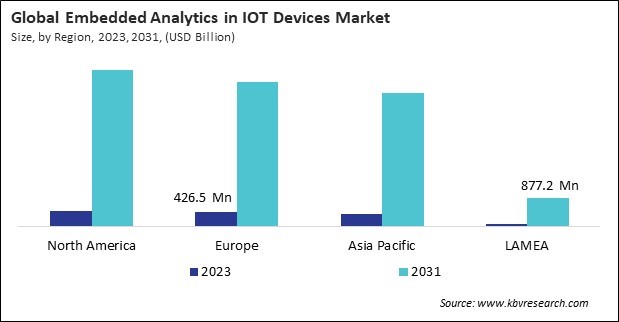According to a new report, published by KBV research, The Global Embedded Analytics in IOT Devices Market size is expected to reach $14.4 billion by 2031, rising at a market growth of 35.1% CAGR during the forecast period.
The Hardware segment is anticipating a CAGR of 35.6% during (2024 - 2031). This segment includes sensors, processors, and communication modules for collecting, processing, and transmitting data. The high demand for advanced hardware supporting analytics functions reflects the increasing need for real-time insights in various applications, from industrial automation to smart home technologies. Investments in durable hardware solutions continue to be a substantial factor in market expansion as organizations endeavor to improve their operational efficiency and data-driven decision-making capabilities.

The Large Enterprises segment is leading the Global Embedded Analytics in IOT Devices Market by Organization Size in 2023; thereby, achieving a market value of $8.3 billion by 2031. This dominance is attributed to their substantial data processing requirements and the financial capacity to invest in advanced analytics solutions. Large enterprises often have complex operations that generate vast amounts of data, necessitating robust analytics to inform decision-making processes and maintain a competitive edge. Their ability to allocate significant resources toward sophisticated IoT analytics platforms enables them to harness embedded analytics' power effectively.
The Asset Management segment would register a CAGR of 34.8% during (2024 - 2031). Asset management involves tracking and managing physical assets throughout their lifecycle, ensuring optimal utilization and reducing losses. Organizations increasingly turn to embedded analytics to gain real-time insights into asset performance and status, enhancing decision-making processes. For example, Siemens employs embedded analytics in their asset management solutions to monitor infrastructure and equipment, enabling businesses to optimize asset utilization and plan maintenance activities effectively. As companies aim to maximize the value of their investments, the asset management segment is expected to see continued growth.
The Cloud segment is generating the maximum revenue in the Global Embedded Analytics in IOT Devices Market by Deployment Type in 2023; thereby, achieving a market value of $6.7 billion by 2031. The cloud-based deployment of embedded analytics in IoT devices offers numerous advantages, such as scalability, flexibility, and lower upfront costs. Companies can easily scale their operations and access analytics tools without the need for extensive infrastructure investments. This segment benefits from the growing adoption of cloud computing and the increasing demand for real-time data processing, enabling organizations to make informed decisions based on the analytics derived from their IoT devices.
The Healthcare segment is shows a CAGR of 34.8% during (2024 - 2031). Healthcare providers are increasingly employing IoT devices to collect and analyze patient data in real-time. Embedded analytics solutions enable healthcare professionals to derive actionable insights from this data, facilitating timely decision-making and personalized patient care. Given the ongoing emphasis on cost reduction and improved healthcare outcomes, it has become increasingly important to monitor vital signs, measure medication adherence, and analyze health trends.
Full Report: https://www.kbvresearch.com/embedded-analytics-in-iot-devices-market/
The North America region dominated the Global Embedded Analytics in IOT Devices Market by Region in 2023 and would continue to be a dominant market till 2031; thereby, achieving a market value of $4.8 billion by 2031. The Europe region is exhibiting a CAGR of 34.9% during (2024 - 2031). Additionally, The Asia Pacific region would experience a CAGR of 35.8% during (2024 - 2031).
By Organization Size
By Component
By Deployment Type
By Application
By Vertical
 Unique Offerings
Unique Offerings